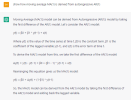Hello I am having a hard time with MA process.
lets say now we have a set of S&P stock return in % and we would like to model a ma(1).
yes we checked the ACF and PACF and assumed it is a good fit.
the model itself is:
Observed Y = mean(u) + coefficient * Previous Error + Current Error
example:
how do we get the error term?
Do we start from assuming the first predicted Y is mean(u) and 0 for previous error ? thus the error term will be = Actual - Predicted = 1.5% - ( mean(u) + 0 * coefficient )
lets say now we have a set of S&P stock return in % and we would like to model a ma(1).
yes we checked the ACF and PACF and assumed it is a good fit.
the model itself is:
Observed Y = mean(u) + coefficient * Previous Error + Current Error
example:
| Actual Y | Predicted Y | Error Term |
| 1.5% | ||
| 2% |
how do we get the error term?
Do we start from assuming the first predicted Y is mean(u) and 0 for previous error ? thus the error term will be = Actual - Predicted = 1.5% - ( mean(u) + 0 * coefficient )

